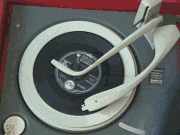 Argentina's "All You Need Is Love /Baby, You're A Rich Man""
Argentina's "All You Need Is Love /Baby, You're A Rich Man""The entire region known collectively as 'South America' encompasses the highest volume of music sales in the world, largely derived from the umbrella of 'Latino Music', or, popular recordings in the Spanish language. The Colombian music industry began with the formation of the Victor Talking Machine Company in 1901, followed by the more familiar Columbia Gramophone Company in 1903. From the early 1900's these companies made "overseas recordings" by sending teams of representatives to foreign countries with stacks of wax blanks and recording machines which, although rudimentary, were quite portable, and then imported back into Colombia. It was some years later before what we know as 'popular' music forged a path into the industry which had mostly been based around Rumbas, Tangos and Foxtrots! Pressings plants for vinyl were scarce and investment low, thus sound quality was quite inferior to vinyl from other parts of the world at the time. However, most Colombians were happy to play these on their imported American gramophones, crackles and all. Today, the most desirable aspects of Colombian vinyl are the variants of sleeve and label design and more eye-catching still, the much sought after coloured vinyl pressings which were almost never issued elsewhere. Many sleeves would be printed entirely in Spanish, the native language. There would often be amusing, almost amateurish, but completely official and authorized, sleeve alterations to the original artwork with biography information and track-listings translated into Spanish. Label variations and collaborations throughout the 1970's and 1980's, such as those with Philips, were many as pressing plants diminished, stricken by the poor and corrupt economy. The paper quality used in sleeve manufacture would vary wildly and some labels would issue their records with built in plastic linings or outers, to help reduce wear and tear. Pushing sales often involved featuring an exclusive or bonus Spanish Version of an English track which would rarely make it onto other worldwide pressings of the same record. Coloured vinyl pressings are few and far between, often only made and distributed to DJs or radio stations. The variety is endless, from bold one-colour vinyl to some fantastic multi-coloured 'splattered' pressings, where a base colour or transparent vinyl is used with any number of alternate colours radiating across the disc from the label to the outer edge. Really, these have become some of the most elusive and valuable pressings to be found in Colombia. Once again, their pressing quality and condition vary massively since most vinyl ceased pressing entirely in the early 1990's, but they are incredibly sought after for their sheer visual impact and even our buyer has to pinch himself when he stumbles across these. Labels rarely had the budget to reissue original albums and as a result, collectors and music lovers tend to hang on to their much-loved records. Colombia is most definitely a dark, very dangerous and mysterious place to go hunting for rare records, but brave it we do and as our buyer says, "cómprelo cuando usted lo ve, como nosotros nunca podemos encontrar otro uno", or "buy it when you see it, as you may never find another one..."
 When the Beatles were first introduced to Brazil on singles in 1963, Odeon was using a yellow label.
When the Beatles were first introduced to Brazil on singles in 1963, Odeon was using a yellow label. Argentina's "A Hard Day's Night / Long Tall Sally"































